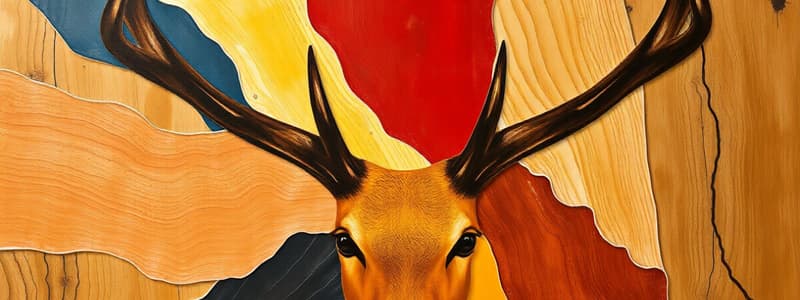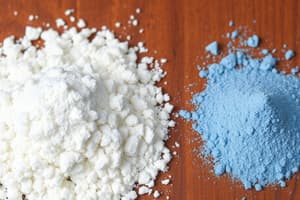Podcast
Questions and Answers
Why was creating a large enough vessel crucial for the tanning process?
Why was creating a large enough vessel crucial for the tanning process?
- To easily mix the oak chips and water.
- To heat the water using hot rocks from the fire.
- To prevent the tannic acid from evaporating too quickly.
- To allow the deer hide to be fully submerged in the tannic acid solution. (correct)
The narrator used ingenuity to create tools and clothing. Which of the following best describes a limitation they faced?
The narrator used ingenuity to create tools and clothing. Which of the following best describes a limitation they faced?
- Difficulty in finding suitable materials in the surrounding environment.
- An inability to hunt big game animals for hides and meat.
- The time and effort required to process raw materials with limited tools. (correct)
- A lack of knowledge on how to effectively use natural resources.
What was the primary purpose of smoking the deer meat?
What was the primary purpose of smoking the deer meat?
- To enhance the flavor for immediate consumption.
- To preserve the meat for later use. (correct)
- To remove excess fat from the meat.
- To make the meat easier to chew.
Why did the narrator decide to create a spearhead from the deer bone?
Why did the narrator decide to create a spearhead from the deer bone?
What is the most likely reason the narrator included acorn flour in the frog soup recipe?
What is the most likely reason the narrator included acorn flour in the frog soup recipe?
Why were jesses important for Frightful, the falcon?
Why were jesses important for Frightful, the falcon?
The narrator attempted to trap a deer using a figure-four trap. Which of the following factors likely contributed to the initial failure of the trap baited with elderberries?
The narrator attempted to trap a deer using a figure-four trap. Which of the following factors likely contributed to the initial failure of the trap baited with elderberries?
What can be inferred about the narrator's evolving relationship with the environment based on their actions?
What can be inferred about the narrator's evolving relationship with the environment based on their actions?
What is the most likely reason The Baron never ate the food left out for him?
What is the most likely reason The Baron never ate the food left out for him?
What does the narrator's reaction to Frightful flying to him without food indicate about their relationship?
What does the narrator's reaction to Frightful flying to him without food indicate about their relationship?
What is implied by the narrator calling Frightful's puffed-up feathers a "feather word?"
What is implied by the narrator calling Frightful's puffed-up feathers a "feather word?"
Why did the narrator begin burning out another tree?
Why did the narrator begin burning out another tree?
What does the narrator's focus on gathering and storing food suggest about their priorities?
What does the narrator's focus on gathering and storing food suggest about their priorities?
How does the narrator's interaction with The Baron contrast with their training of Frightful?
How does the narrator's interaction with The Baron contrast with their training of Frightful?
What can be inferred from the narrator needing a "bin" for hickory nuts, walnuts and acorns?
What can be inferred from the narrator needing a "bin" for hickory nuts, walnuts and acorns?
How does the appearance of "hikers and vacationers" contribute to the central themes?
How does the appearance of "hikers and vacationers" contribute to the central themes?
Flashcards
The Baron
The Baron
The narrator's wild animal companion who never eats offered food but seems to enjoy the narrator's company.
Falcon training
Falcon training
Training a falcon by having it fly to the trainer's fist for food.
Trained whistle
Trained whistle
A signal, in this case a whistle, that means "Come" to Frightful.
"Feather word"
"Feather word"
Signup and view all the flashcards
Resource gathering
Resource gathering
Signup and view all the flashcards
Tree niche
Tree niche
Signup and view all the flashcards
Nut bin
Nut bin
Signup and view all the flashcards
Human interference
Human interference
Signup and view all the flashcards
Tanned Hide
Tanned Hide
Signup and view all the flashcards
Tannic Acid
Tannic Acid
Signup and view all the flashcards
Jesses
Jesses
Signup and view all the flashcards
Frog Spear
Frog Spear
Signup and view all the flashcards
Figure-Four Trap
Figure-Four Trap
Signup and view all the flashcards
Deer Bait
Deer Bait
Signup and view all the flashcards
Oak chips
Oak chips
Signup and view all the flashcards
Tanning
Tanning
Signup and view all the flashcards
Study Notes
- The author spends free time preparing deer hide for tanning, aware that tannic acid is necessary for the process
- It takes the author weeks to successfully extract tannic acid from oak trees
- Tannic acid comes from oak chips steeped in water
- The main challenge was finding a vessel large enough to hold the deer hide for steeping
The Solution
- An oak stump is used to steep deer hide in tannic acid
- The author fells an oak tree near the gorge and burns a hole in the stump to create a vessel
- The deerskin steeps for about five days
- After drying, the hide is stiff and requires chewing, rubbing, jumping, and twisting to soften it
- The softened deerskin serves as a door hung on pegs at the entrance
- Extra pieces of deerskin are cut and used to fashion jesses, or leg straps, for Frightful
- All well-trained falcons wear jesses and leashes for tethering
- Smoked meat is stored, and no part of the animal goes to waste
- A deer bone is crafted into a two-pointed spearhead, making it easier to catch frogs after struggling.
- Favorite meals include frog soup: clean skin, boil until tender, add wild onions, water lily bulbs, wild carrots, thicken with acorn flour, and serve in a turtle shell
- The author dreams of a deerskin suit to replace threadbare pants and frayed sweaters.
The Deer Suit
- Creating a trap for deer under the log
- The author initially uses elderberries as bait, but they don't work
- Hickory salt mixed with turtle fat is used as bait
- Frightful and The Baron Weasel accompany the author to observe the trap near the aspen grove
- One night, three deer approach the log, drawn by the smell of salt
- The Baron bites the author's ankle, causing the deer to flee
- The Baron's behavior is puzzling because he never eats the turtle or venison left out
- The author considers that The Baron might be a lonely animal seeking companionship
- Regardless, the author appreciates The Baron's presence
The Baron
- Every day the author works to train Frightful
- Frightful is placed on her stump with a long leash
- The author steps back with meat and whistles, associating the whistle with food
- After several attempts, Frightful eventually flies to the author's hand
- The author pets and feeds her, ensuring she only eats after flying to the fist
Frightful's Training
- One morning, Frightful flies to the author upon hearing the whistle, even without food or hunger
- The author is thrilled and realizes Frightful has learned that the whistle means "Come"
- A gentle recognition is seen in her steely eyes, and she puffs up her feathers, indicating contentment
- The author gradually increases the distance Frightful must fly
- One day, Frightful flies fifty feet
Summer
- Celebrates with seeds, bark and tubers
- Uses an old sweater for gathering, mentally designing better pockets for the future deer-hide suit
- Summer provides an abundance of food
- Food is gathered in the morning and stored in the afternoon
- Notches will not be big enough for the amount of food needed for winter, so another tree begins burning out
- A bin will be needed for hickory nuts, walnuts, and acorns
- With the easy living of the summer also comes a threat
- Hikers and vacationers in the woods cause concern
Studying That Suits You
Use AI to generate personalized quizzes and flashcards to suit your learning preferences.
Description
The author prepares deer hide for tanning using tannic acid extracted from oak trees. An oak stump is repurposed as a vessel to steep the hide. The softened deerskin is used as a door and to craft jesses for Frightful, along with a spearhead from deer bone.




